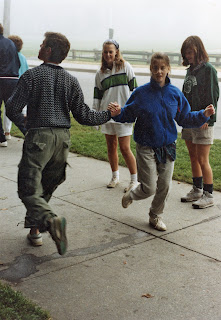 What had started with just 16 tripees and a few trip leaders had grown by 1970 to the point where nearly half of the incoming class participated in Freshman Trips. Today the program involves over 90 percent of the freshman class and more than two hundred upperclassmen student leaders.
What had started with just 16 tripees and a few trip leaders had grown by 1970 to the point where nearly half of the incoming class participated in Freshman Trips. Today the program involves over 90 percent of the freshman class and more than two hundred upperclassmen student leaders.Over the years, the Dartmouth Outing Club has devised new and creative ways for freshmen to break out of their shells during their first days with their new Dartmouth peers. The first day in Hanover usually involves a variety of semi-embarrassing activities such as dancing on the lawn in front of Robinson Hall and humorously choreographed safety talks. After that they head out on their trips, which have evolved from just hiking to include a variety of activities including, kayaking, canoeing, fly-fishing, mountain biking, horseback riding, nature photography, organic farming and even nature writing and painting for the artistically inclined.
After two nights in the outdoors, the groups reconvene at the Ravine Lodge at the base of Mt. Moosilauke and are treated to stories from administrators, faculty, or alumni about their own Dartmouth experiences.
In the morning, the freshmen enjoy a complete breakfast of green eggs and ham, inspired by Dartmouth alumnus Theodor Geisel (class of 1925), more commonly known as Dr. Seuss.
This common experience has become a vital part of acclimation to the Dartmouth community, and many first-year students make some of their best and longest-lasting friendships with their tripees. Because of this, Freshman Trips have come to symbolize the strong sense of community and camaraderie that brings former students back to Dartmouth year after year.



